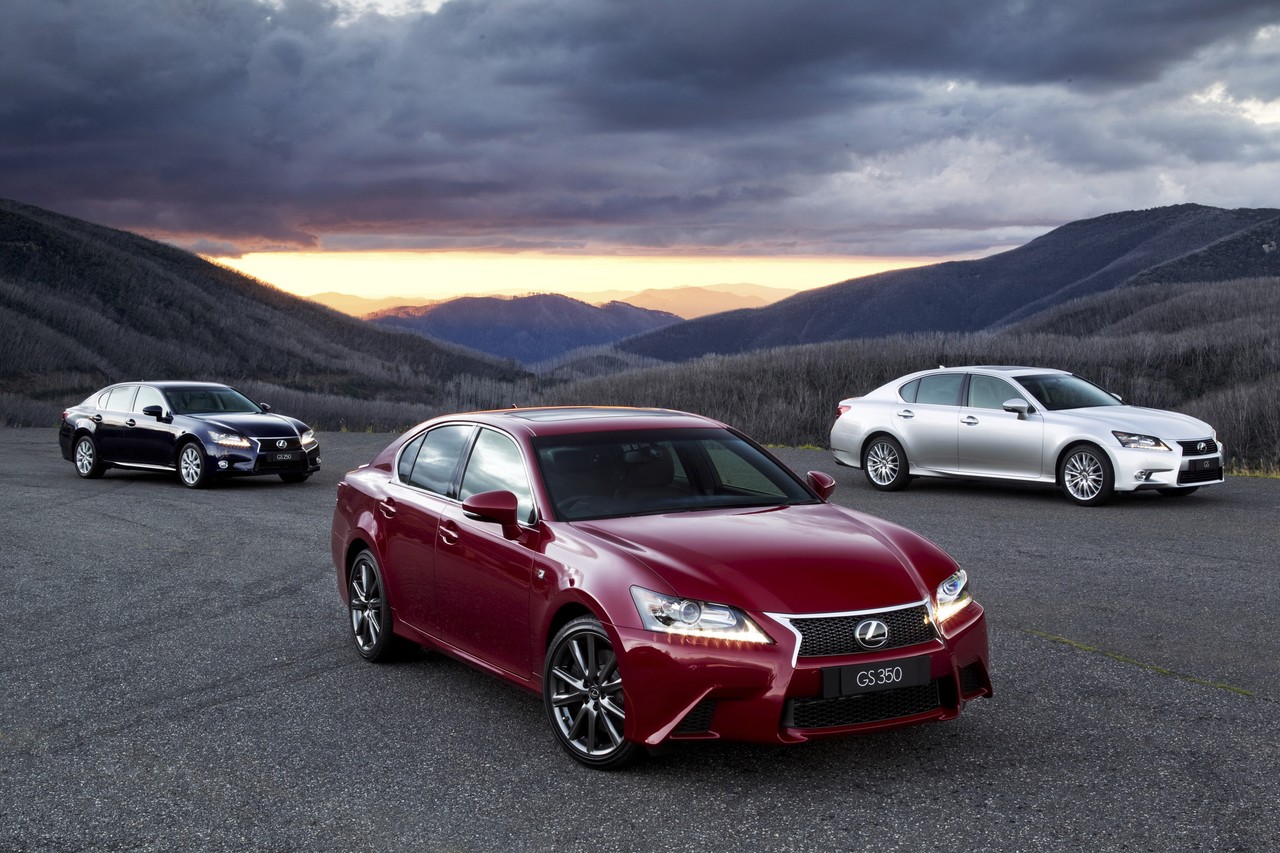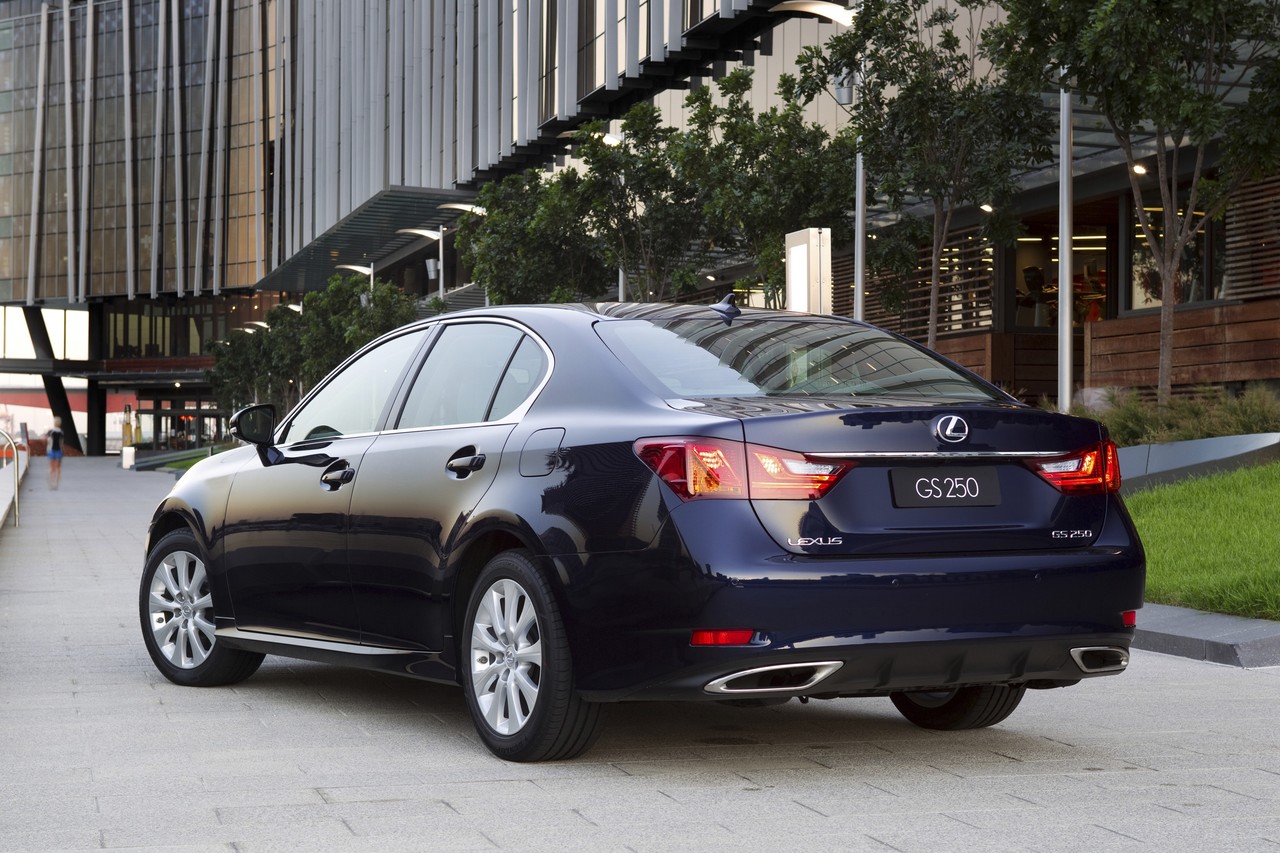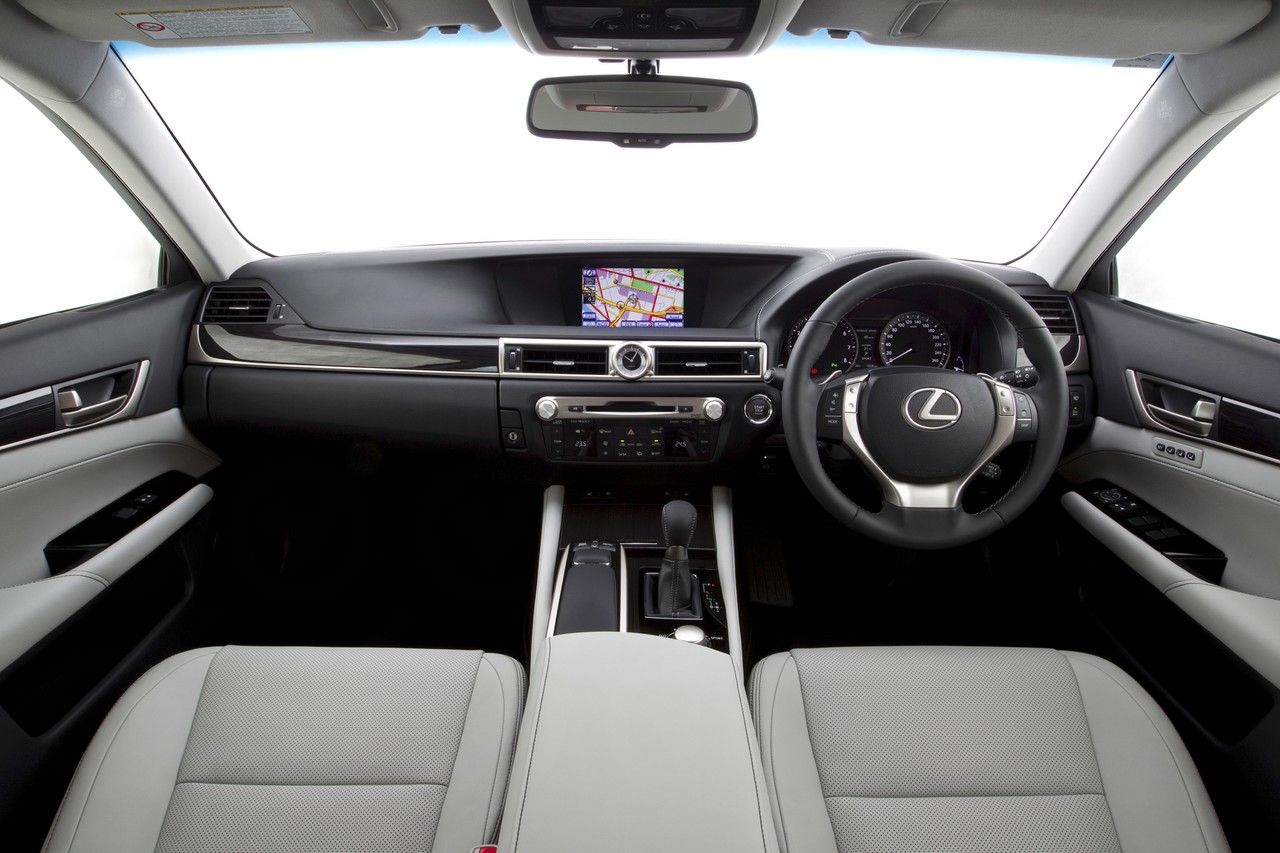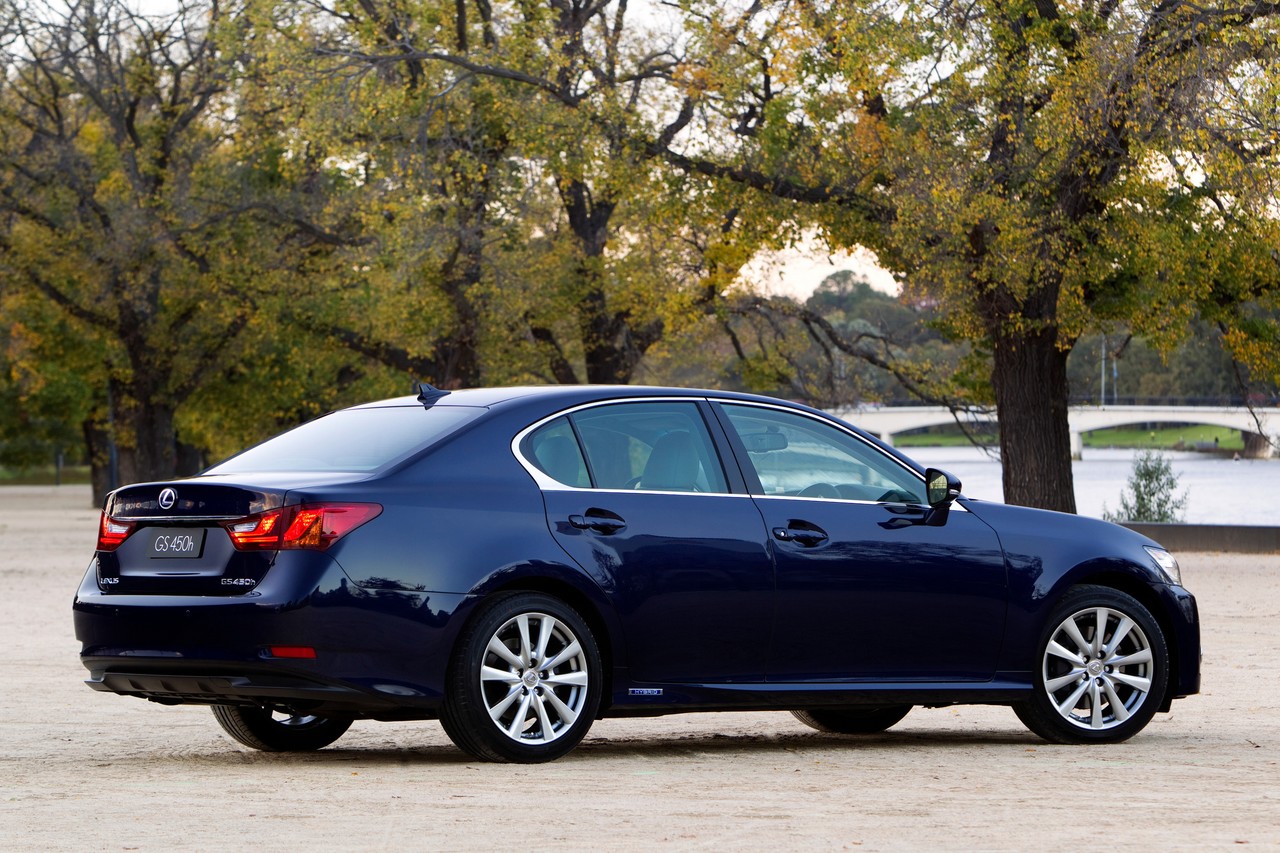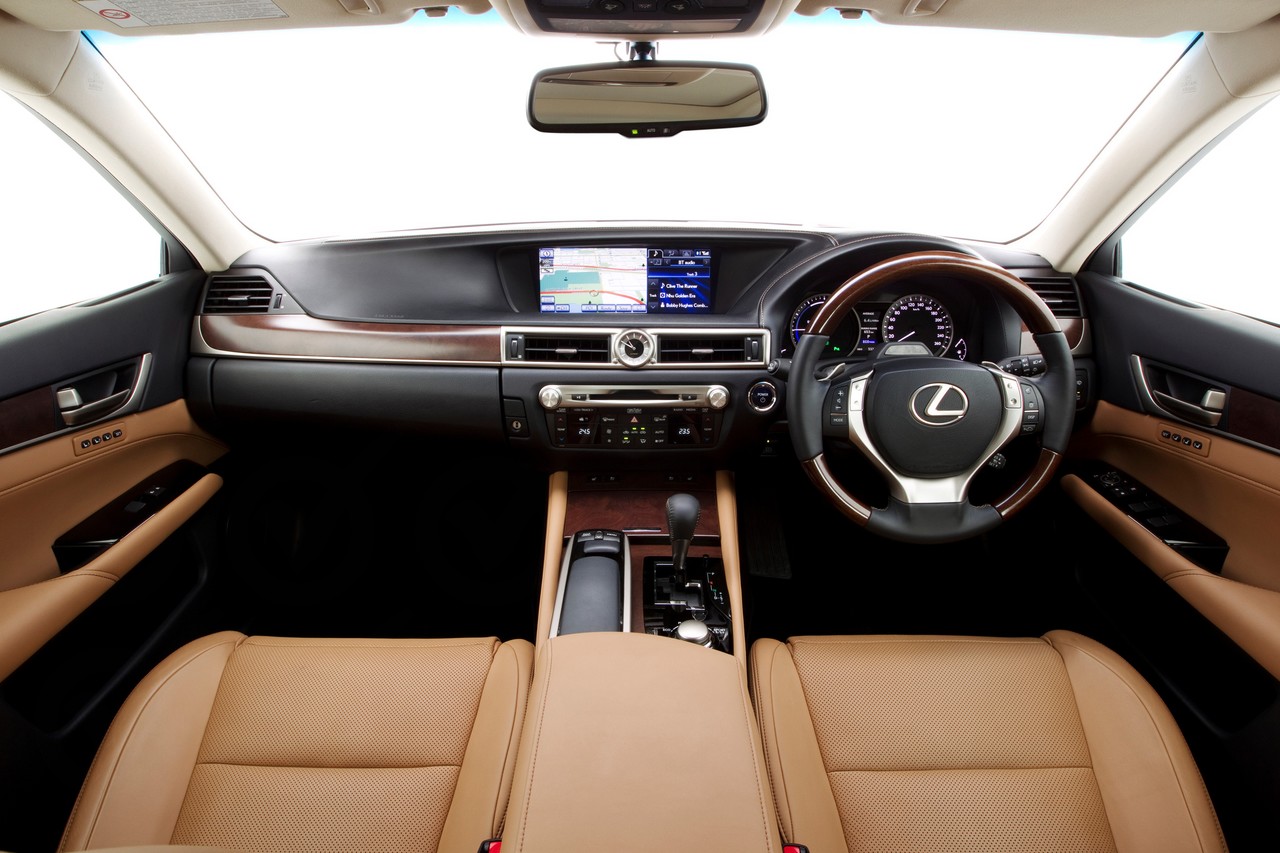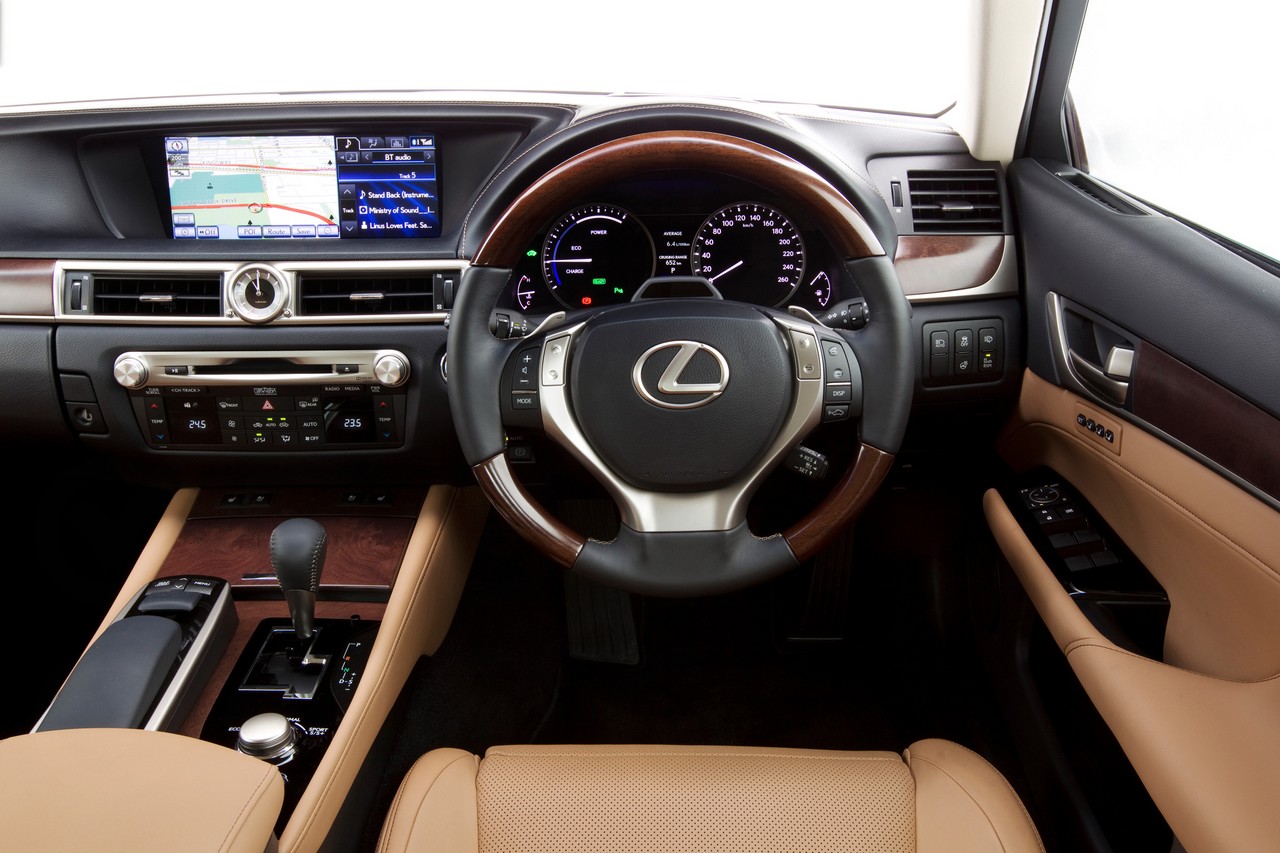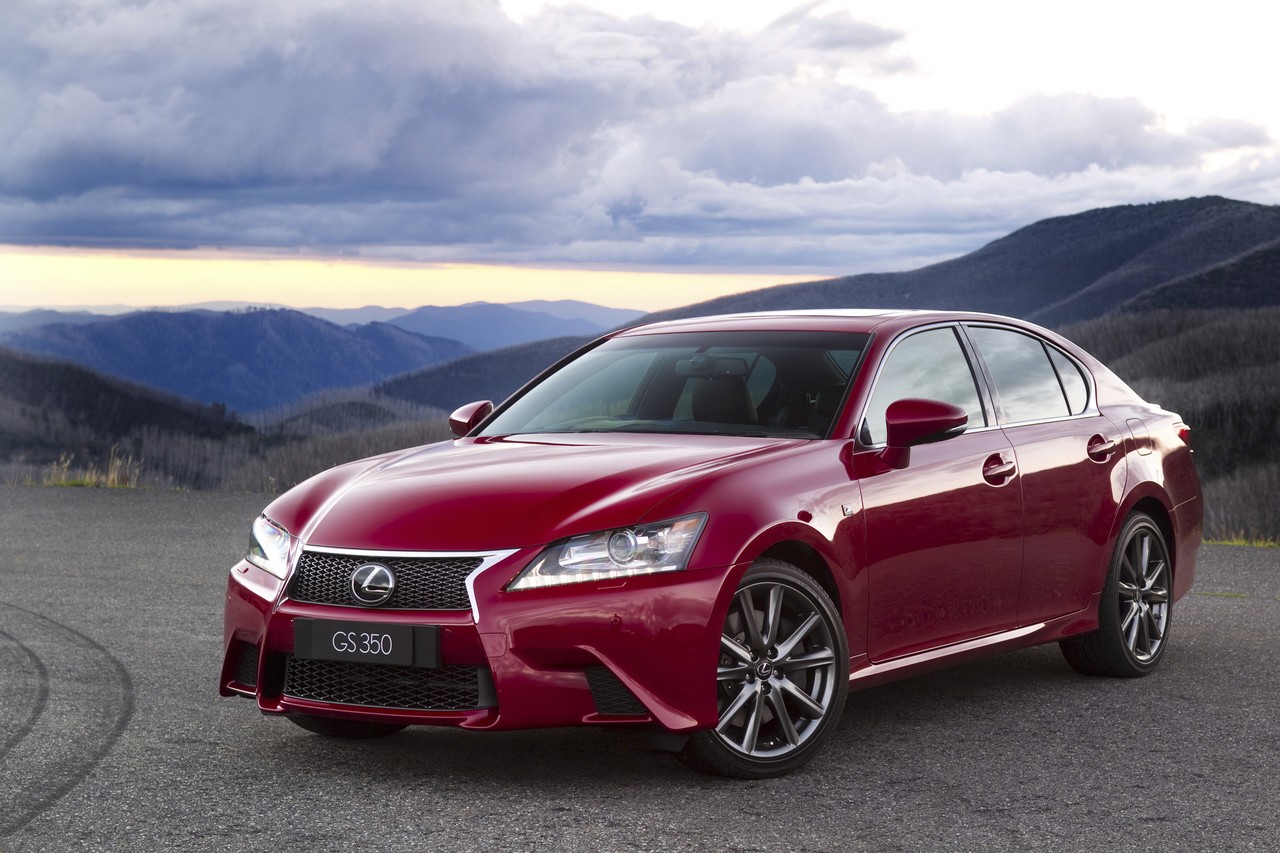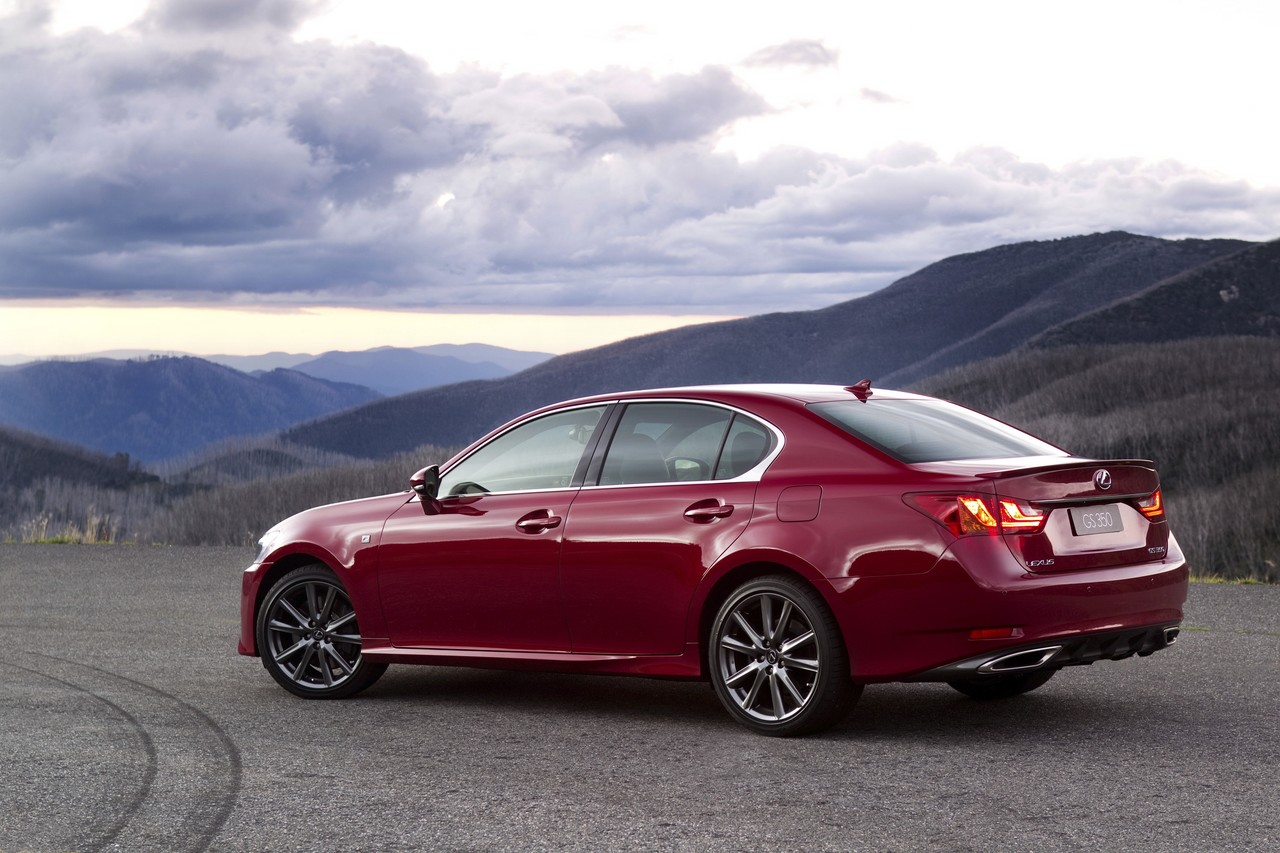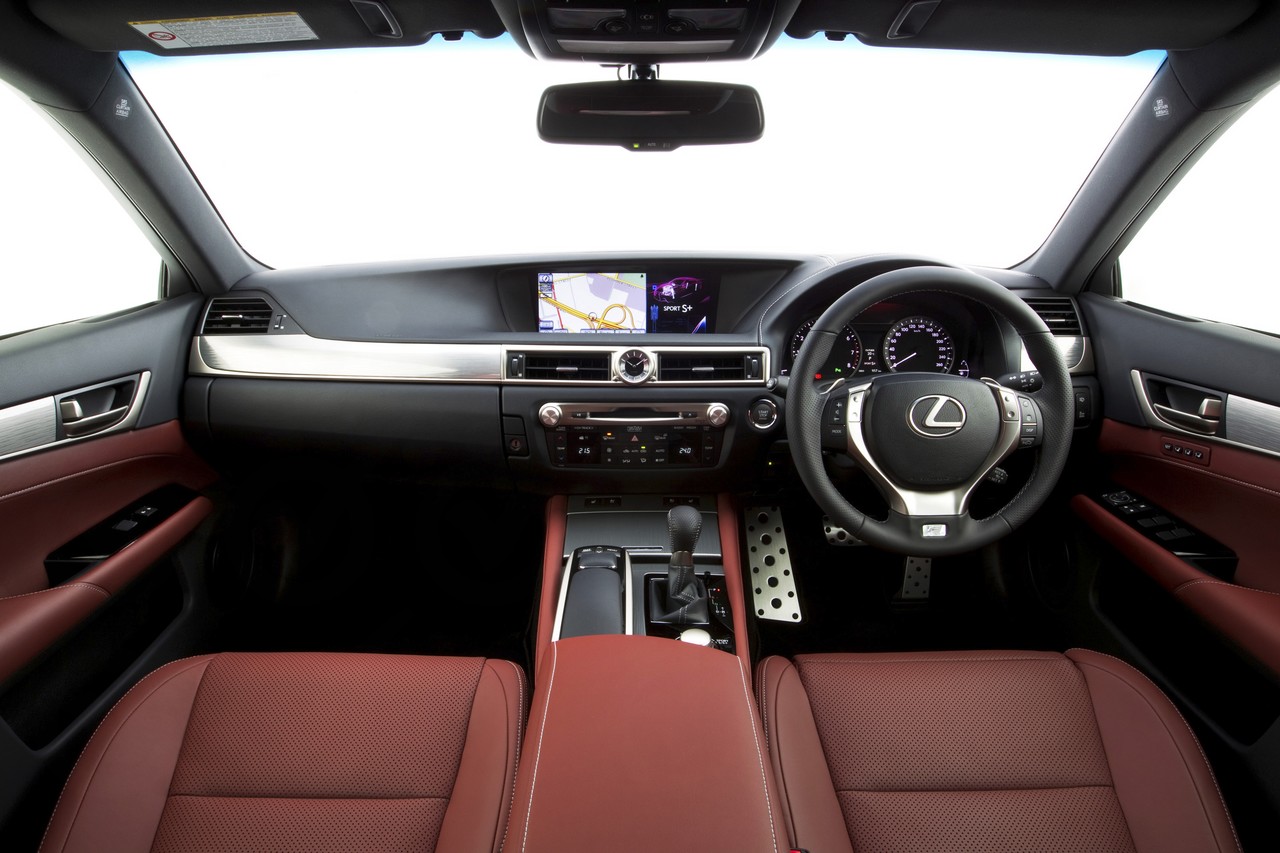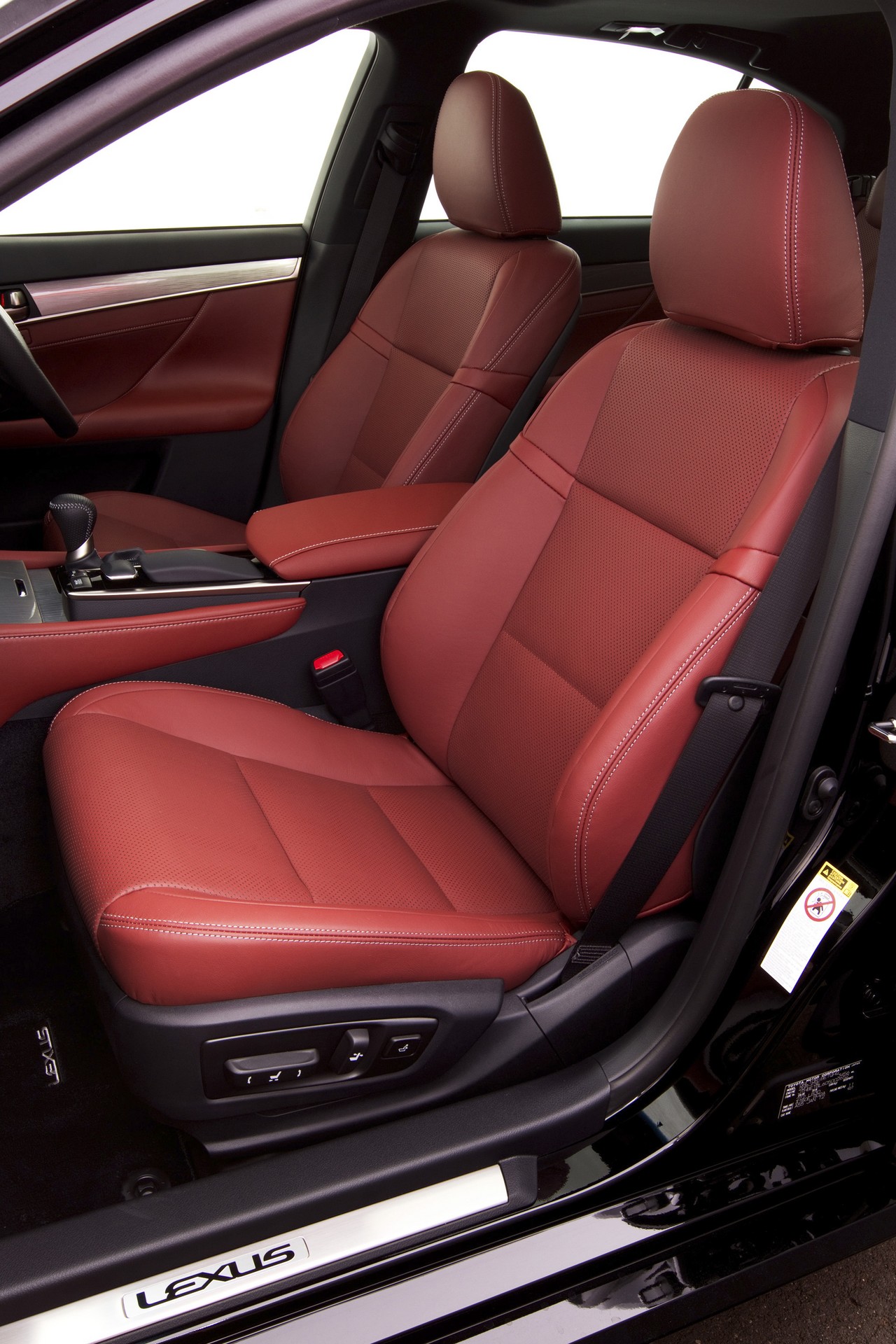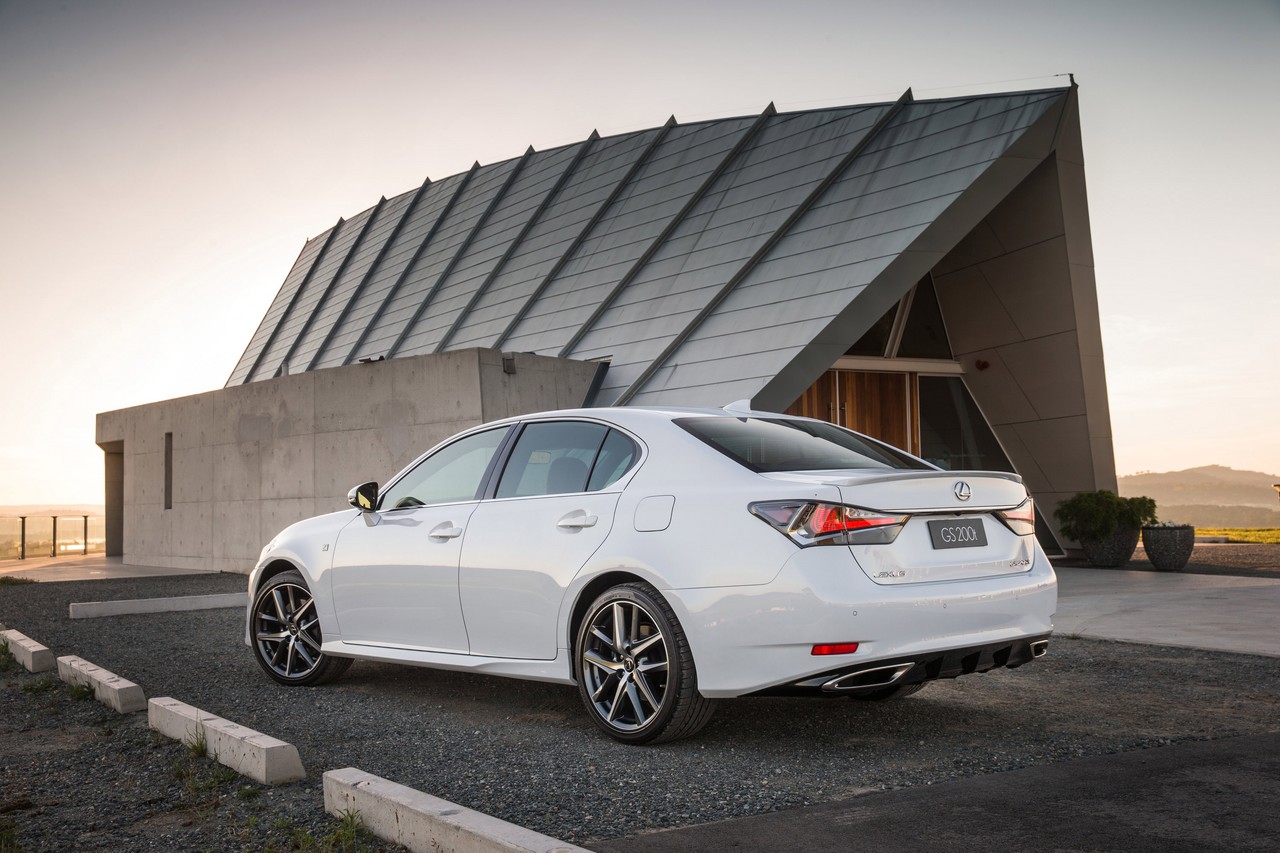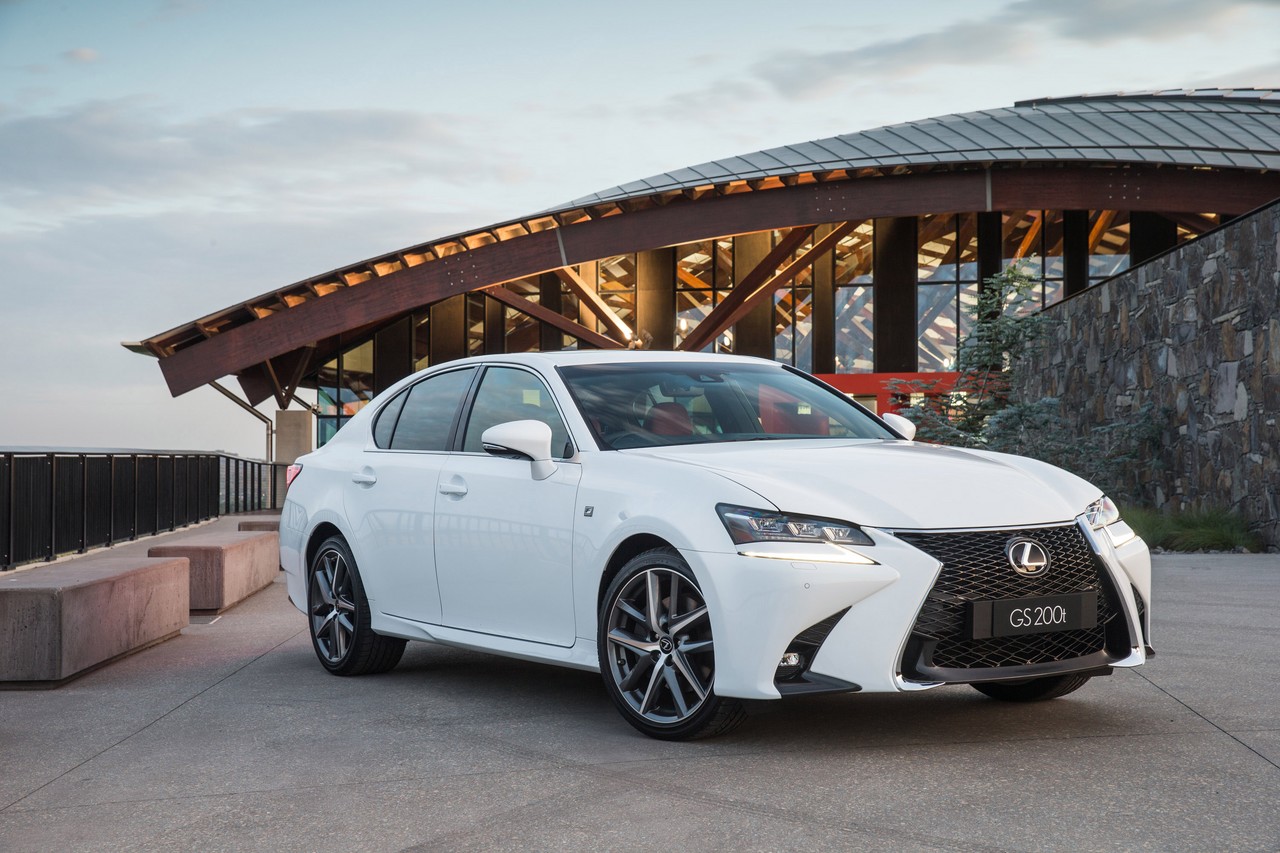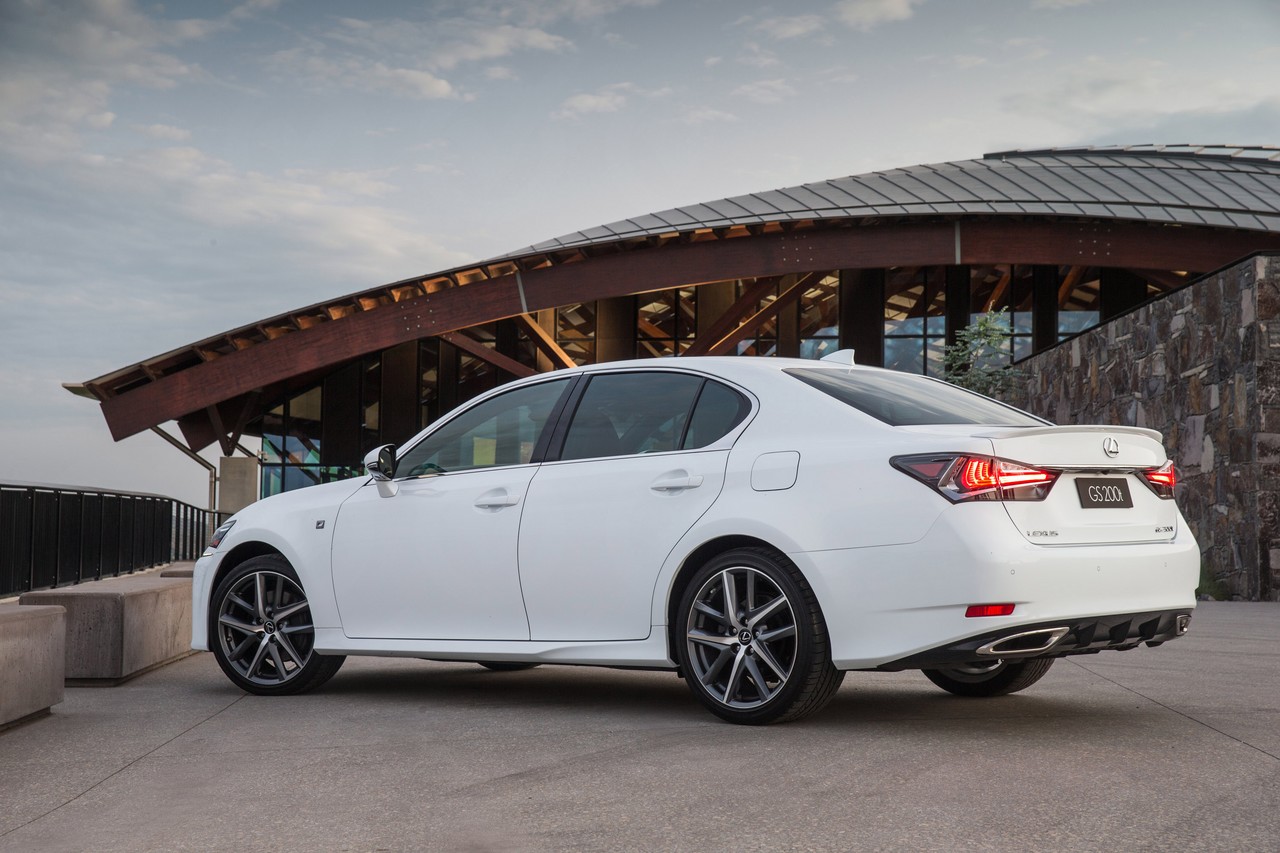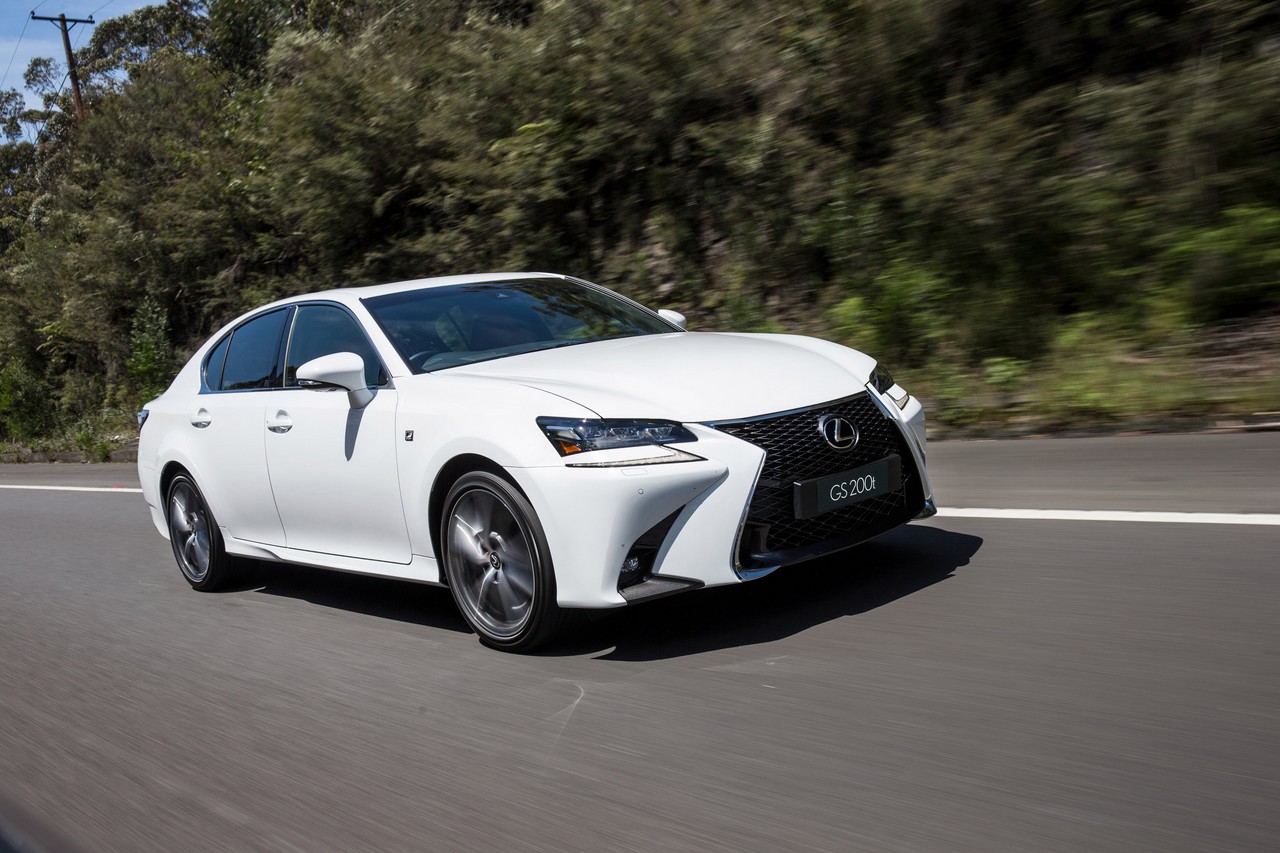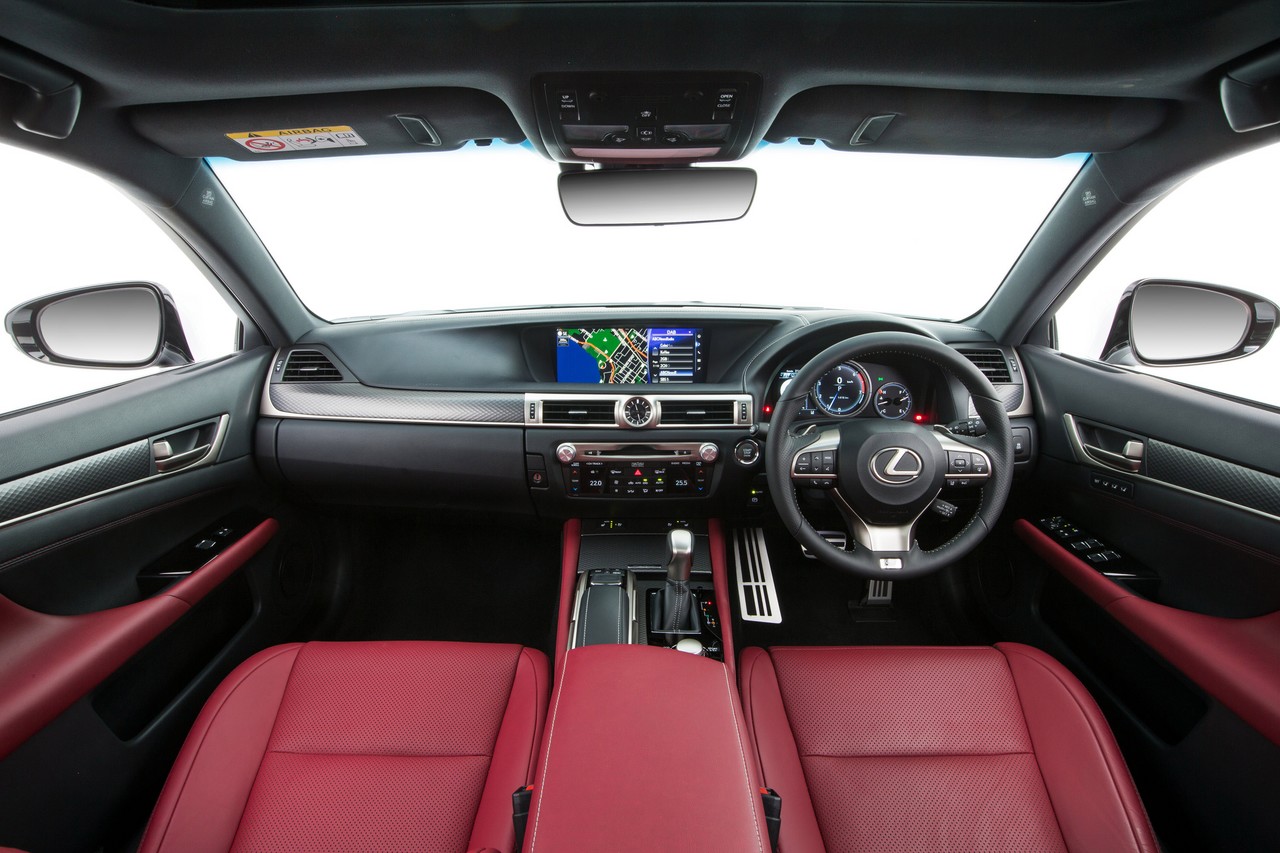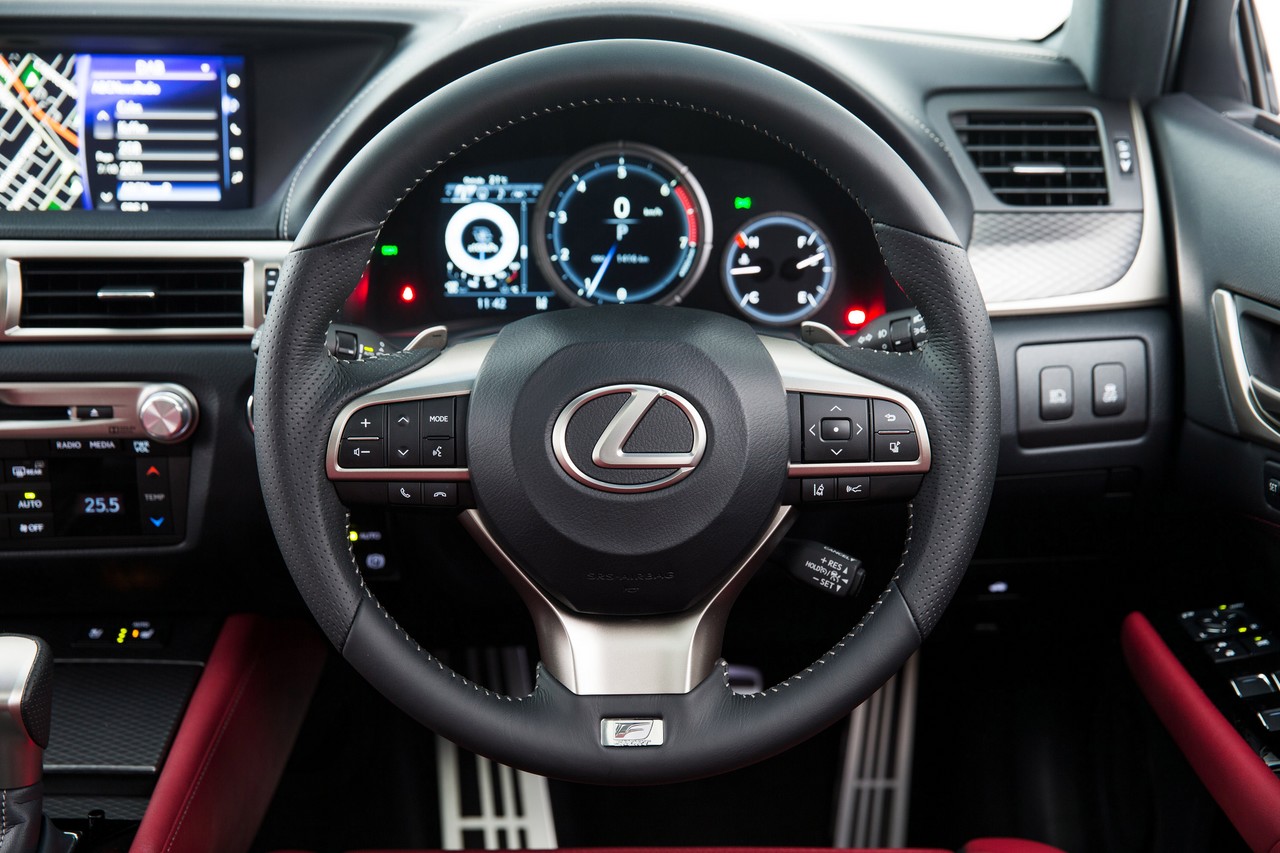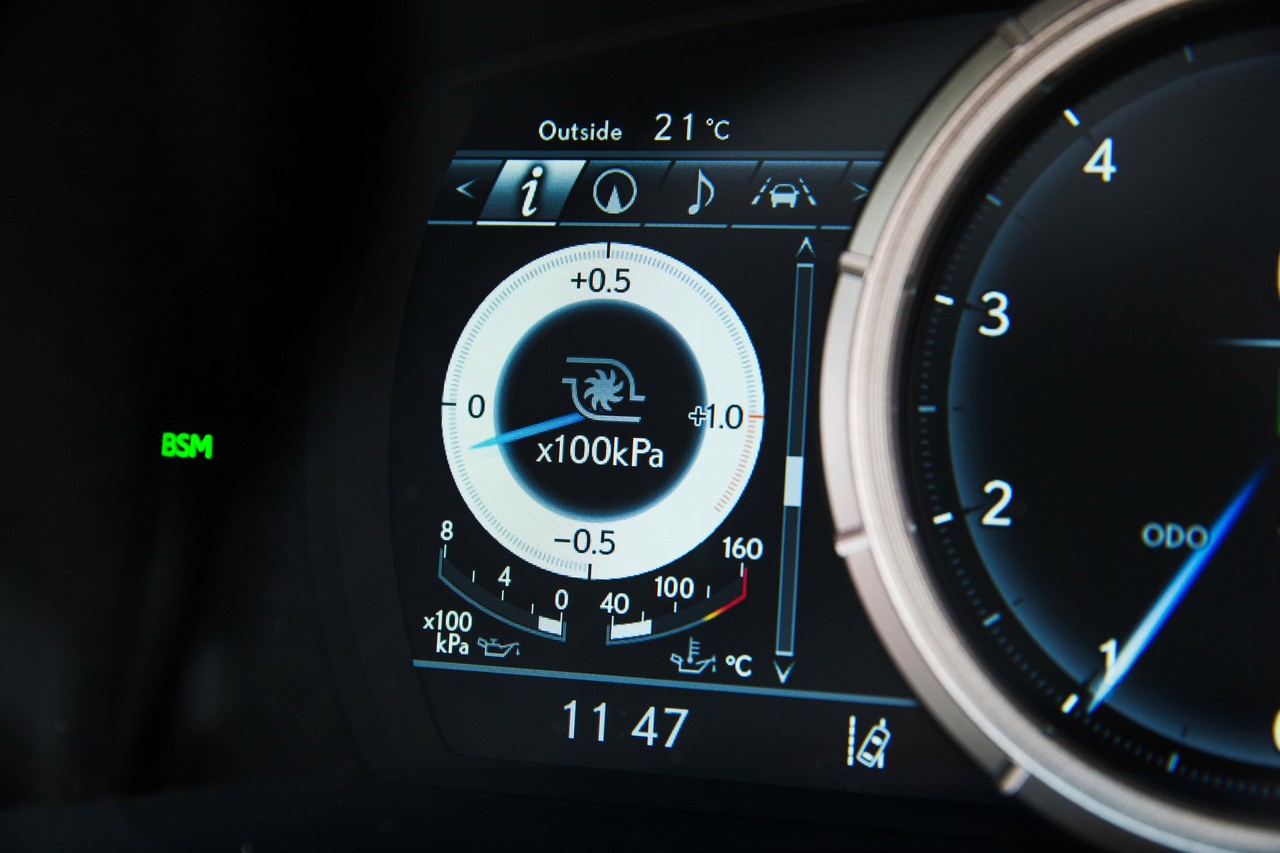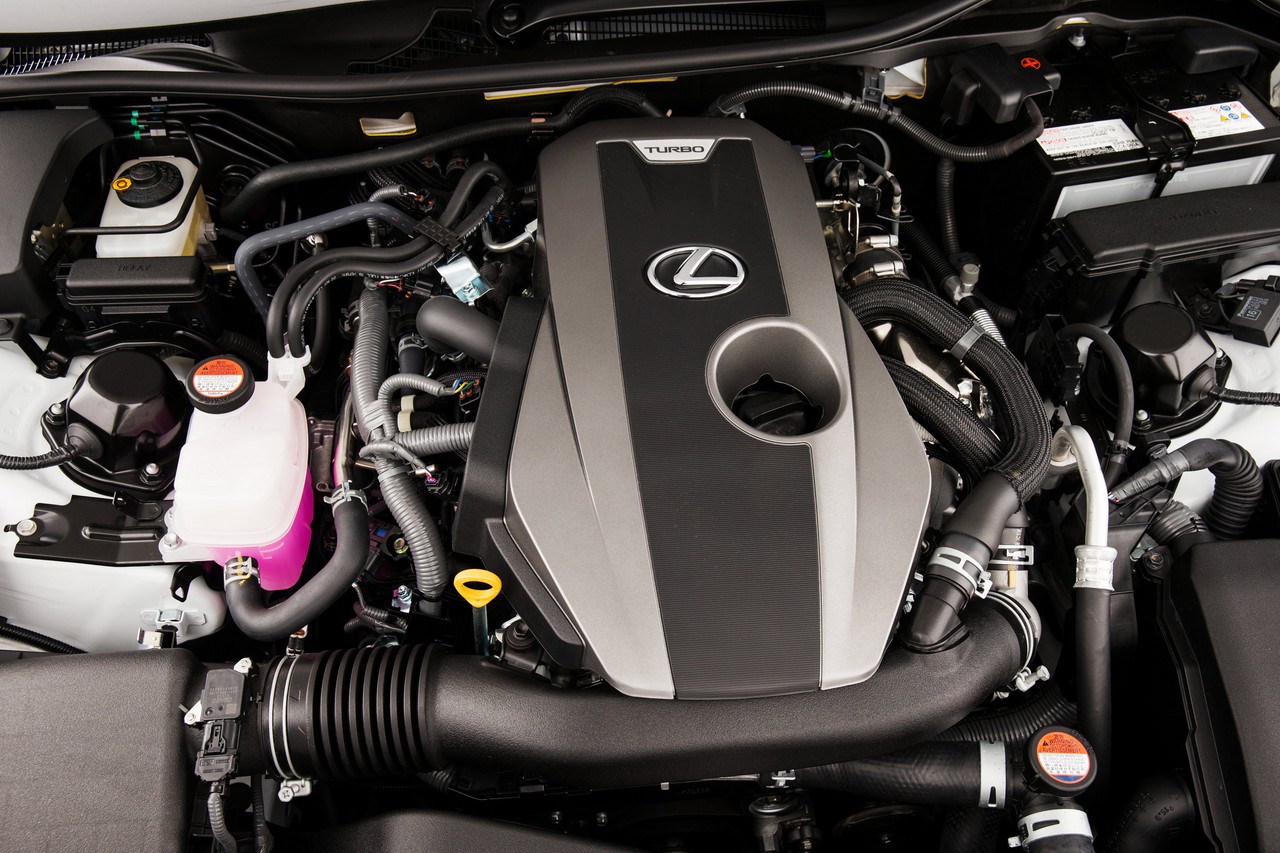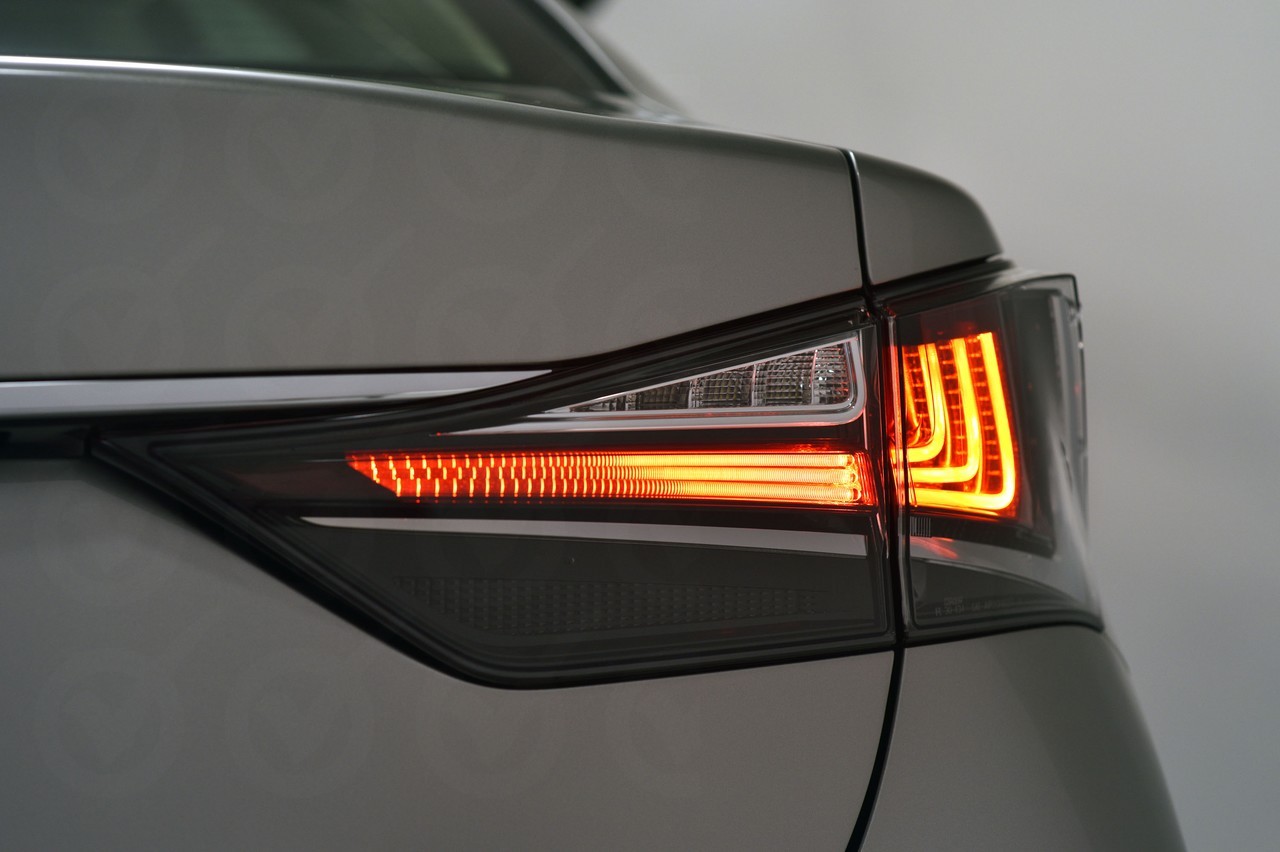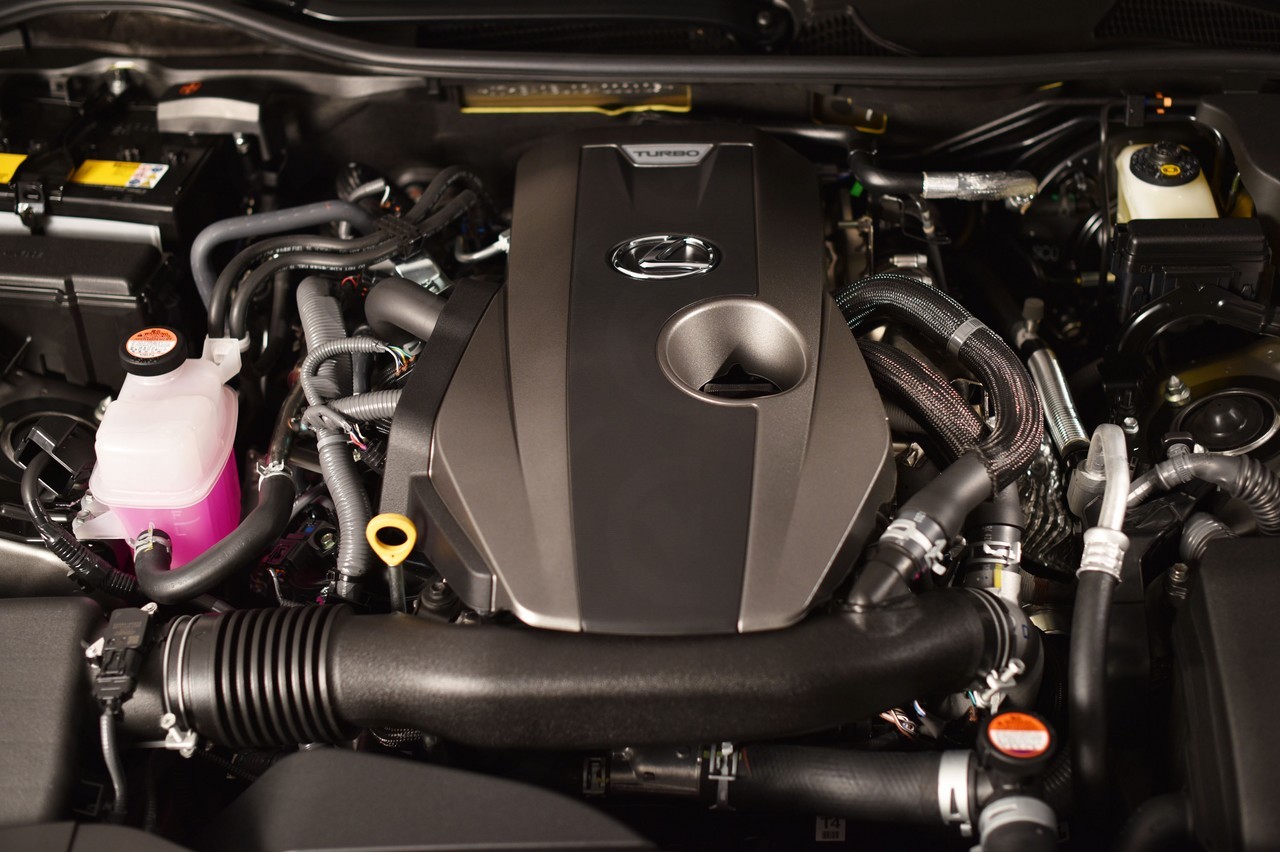
- For GS 350, powerful and refined 3.5-litre V6 engine
- For GS 450h, fuel-efficient and responsive hybrid powertrain
- Impressive ride/handling balance
- High standard of interior fit and finish
- Quiet, well-insulated cabin
- Steering is accurate…
- … but lacks feel
- For F Sport variants, suspension lacks compliance
- Sensitive ESC calibration
- Limited rear seat and boot space
- Thirsty 3.5-litre V6 engine
Review: Lexus L10.I GS (2012-15)
Overview
Released in April 2012, the Lexus L10 Series I (L10.I) GS was an executive sedan. The L10 GS range initially consisted of the GS 250 and GS 350, powered by 2.5- and 3.5-litre V6 petrol engines respectively. The L10 GS range was subsequently expanded with the hybrid-powered GS 450h in May 2012 and the GS 300h in November 2013 (see ‘Hybrid models: GS 300h and GS 450h’, below). Each model was available in Luxury, F Sport and Sports Luxury variants; in Luxury and Sports Luxury variants, drivers could select from Eco/Normal and Sport driving modes.
Engines: GS 250 and GS 350
For the GS 250 and GS 350,
- The 2.5-litre 4GR-FSE V6 engine had an aluminium block and cylinder head, direct-injection, double overhead camshafts (per cylinder bank), four valves per cylinder, variable intake and exhaust valve timing, an electronically-controlled acoustic induction system (ACIS) and a compression ratio of 12:1; and,
- Compared to the 4GR-FSE engine , the 3.5-litre 2GR-FSE engine simultaneously combined direct injection with traditional port injection for more precise air/fuel mixing under low and medium load conditions. Furthermore, ACIS was omitted and the compression ratio was reduced to 11.8:1.
Hybrid powertrains: GS 300h and GS 450h
For the GS 300h and GS 450h, both the 2.5-litre 2AR-FSE four-cylinder and 3.5-litre 2GR-FXE V6 Atkinson cycle engines had double overhead camshafts (DOHC), direct and port injection (D-4S), variable intake and exhaust valve timing (dual VVT-i), and compression ratios of 13.0:1. Furthermore, both the hybrid powertrains included:
- Two electric motors with one to act primarily as a generator and the other as the main drive motor;
- A water-cooled, 650-volt permanent magnet electric motor which drew power from nickel metal hydride (Ni-MH) batteries positioned under the luggage deck board; and,
- A planetary-gear continuously variable transmission (CVT) with six pre-set ratios that could be selected via steering wheel gearshift paddles.
The GS 300h and GS 450h enabled the driver to select from five drive modes –
- ‘EV’ (electric vehicle) mode: provided up to 2 km of range with a maximum speed of 50 km/h;
- ‘Eco’ mode: voltage for the hybrid system was generally limited to 500 volts, engine shut-down times were increased, throttle response was dulled and air conditioner and compressor fan speeds were reduced;
- ‘Normal’: provided standard throttle response;
- ‘Sport’: voltage for the hybrid system was increased to 650 volts, throttle and transmission responses were more aggressive; and,
- ‘Sport+’: firmer suspension damper settings, more direct steering, additional rear wheel steering and less intrusive stability control settings.
| Variants | Engine | Trans. | Peak power | Peak torque | |
|---|---|---|---|---|---|
| GS 250 | Luxury, F Sport, Sports Luxury |
2.5-litre petrol V6 (4GR-FSE) | 6sp auto | 154 kW at 6400 rpm | 253 Nm at 4800 rpm |
| GS 300h | Luxury, F Sport, Sports Luxury |
2.5-litre petrol I4 (2AR-FSE) | 6sp CVT | 133 kW at 6000 rpm | 221 Nm at 4200 rpm |
| 650V synchronous electric motor | 105 kW | 300 Nm | |||
| Combined | 164 kW | N/A | |||
| GS 350 | Luxury, F Sport, Sports Luxury |
3.5-litre petrol V6 (2GR-FSE) | 6sp auto (2012-13), 8sp auto (2013-15) |
233 kW at 6400 rpm | 378 Nm at 4800 rpm |
| GS 450h | Luxury, F Sport, Sports Luxury |
3.5-litre petrol V6 (2GR-FXE) | 6sp CVT | 215 kW at 6000 rpm | 352 Nm at 4500 rpm |
| 650V synchronous electric motor | 147 kW | 275 Nm | |||
| Combined | 254 kW | N/A | |||
Dimensions
Compared to the Lexus S190 GS , the L10 GS was 22 mm longer (at 4850 mm), 19 mm narrower (1840 mm) and 30 mm taller (1455 mm), though wheelbase length was unchanged (2850 mm). Furthermore, the L10 GS achieved a 14 per cent increase in torsional rigidity through the increased use of ultra-high strength tensile steel, more spot welds and targeted laser welds.
Suspension
The Lexus L10 GS had double wishbone front suspension with forged aluminium upper and lower arms and independent, multi-link rear suspension. F Sport and Sports Luxury variants were also fitted with ‘Adaptive Variable Suspension’ (AVS) which provided simultaneous control of the damping force to all four wheels; drivers could also increase damper force via the ‘Sport+’ drive setting.
Safety equipment
Standard safety equipment for the Lexus L10 GS included dual front airbags, driver’s knee airbag, front and rear side airbags, full-length curtain airbags, ABS, electronic brake force distribution, brake assist, electronic stability control, traction control, active front seat head restraints and front seatbelts with pretensioners and load limiters. Also fitted as standard, the Blind Spot Monitor (BSM) system was activated once the vehicle exceeded 40 km/h and used sensors in the rear bumper to detect vehicles in adjacent lanes.
The GS 350 F Sport, GS 450h F Sport and all Sports Luxury variants were equipped with the ‘Lexus Advanced Pre-Collision Safety System’ (PCS) which included:
- Collision Warning;
- Pre-Collision Brake Assist;
- Pre-Collision Braking (i.e. autonomous emergency braking or AEB);
- Pre-Collision seatbelt tensioning; and,
- For the GS 350 F Sport, collision avoidance support via the Dynamic Rear Steering (DRS) system.
The Sports Luxury variants were also fitted with a driver fatigue monitor that continuously monitored the driver’s eye and head movements and could provide audible and visual warnings.
From November 2013, all GS Sports Luxury variants were fitted with a Lane Keep Assist system which could detect when the driver unintentionally drifted out of their lane and warn the driver via steering wheel vibrations and an audible tone.
From October 2014, all GS models were fitted with a Rear Cross Traffic Alert (RCTA) system as standard; the RCTA system could detect approaching vehicles as the GS was reversing.
Features: GS Luxury
Standard features for the GS 250 Luxury included 17-inch alloy wheels, a twelve speaker sound system with digital radio (DAB+), a CD/DVD player, auxiliary inputs (3.5mm/USB/iPod) and Bluetooth audio streaming, dual-zone climate control air conditioning, satellite navigation, ten-way power adjustable and ventilated front seats, leather trim, cruise control, directional bi-xenon headlights with washers, automatic headlights, rain-sensing wipers, front and rear parking sensors, a reversing camera, Bluetooth mobile phone connectivity with voice recognition, a multi-function steering wheel with gearshift paddles, remote central locking with proximity key, power windows and heated mirrors with folding function, a height and reach adjustable steering wheel, driver’s seat and mirror memory settings, an electrochromatic rear-view mirror, tyre pressure monitoring, ambient lighting, a trip computer, alarm and an immobiliser.
The GS 350 Luxury was further equipped with 18-inch alloy wheels, while the GS 450h Luxury added a fifteen-way power adjustable driver’s seat, head-up display, moonroof and adaptive suspension. The adaptive suspension system provided simultaneous control of the damping force to all four wheels to improve ride comfort and stability.
In November 2013, the head-up display (HUD) was upgraded so that it projected vehicle speed, navigation, audio information onto the windscreen in full colour.
Features: GS F Sport
Compared to the GS 250 Luxury, the GS 250 F Sport was further equipped with 19-inch alloy wheels, adaptive sports suspension and sixteen-way adjustable contoured front sports seats. Visually, the F Sport variants could be identified by their sports body kits, mesh grilles, metallic interior highlights, sports pedals and scuff plates.
Beyond this, the GS 350 and GS 450h F Sport variants were fitted with active cruise control, and the GS 350 gained a head-up display (already standard for the GS 450h Luxury). Furthermore, the GS 450h F Sport was fitted with an eighteen-way power adjustable driver’s seat and an 835 watt Mark Levinson sound system which had 17 speakers. From October 2014, the GS 350 F Sport was also fitted with the Mark Levinson sound system as standard.
Both the GS 350 and GS 450h F Sport were fitted with larger two-piece brake rotors, four-piston front brake calipers, rear-wheel steering (up to two degrees of rotation) and variable gear ratio steering.
Features: GS Sports Luxury
Compared to Luxury variants, the Sports Luxury variants were further equipped with 18-inch alloy wheels, a seventeen speaker Mark Levinson sound system with digital sound processing, a 12.3-inch navigation display, three-zone climate control air conditioning (with rear controls), 20-way power adjustable front seats, leather upholstery, active cruise control, head-up display, side and rear window shades and woodgrain interior trim.
The GS 450h was further equipped with high and low-beam LED headlights.
FFrom November 2013, Sports Luxury variants were fitted with 19-inch alloy wheels (previously 18-inch alloys) and LED fog lights as standard.
October 2014 update
From October 2014, the Lexus GS had a more rigid chassis due to its re-engineered A-pillar, higher rigidity glass and new adhesives. Furthermore, Lexus’ ‘Enform’ connected mobility system was introduced – it included SD card-based navigation (which could alert drivers to speed and red light cameras, and school zones) and dual USB ports.
Brochure
Related links
- Press Kit: Lexus L10 GS 250 and GS 350 (April 2012)
- Press Kit: Lexus L10 GS 450h (May 2012)
- Press Release: Lexus L10 GS update (November 2013)
Review: Lexus L10.II GS (2015-20)
Overview
Released in Australia in December 2015, the Lexus L10 Series II (L10.II) GS introduced a revised line-up as the GS 200t replaced the GS 250. The Lexus L10.II GS could be identified by its more pronounced spindle grille, bi-LED headlights, 20 mm lower rocker moulding, revised rear bumper and more aggressively profiled rear combination lamps with chrome-plated mouldings for the outer lens.
Body
For the Lexus L10.II GS, the following changes were introduced for a more rigid body:
- 188 additional spot-welds were applied to the frame to improve panel-coupling rigidity. These spot welds were concentrated on the cowl, the junction of the rocker panels and B-pillar, and the rear shelf;
- An additional 22.5 metres of body adhesive was applied; and,
- The door surrounds had an additional 132 laser-screw welding points.
For a quieter interior, sound absorbing material was added to the upper cowl area. Underbody aerodynamics were also improved by positioning the bottom edge of the front bumper 10 mm further forward to adjust the volume of air passing under the floor.
Suspension and steering
For the Lexus L10.II GS, the front and rear suspension both had a new calibration for the coil springs, while front stabiliser bar shape and characteristics were modified. Furthermore, the shape of the free piston in the conventional and AVS damper units (for the GS F Sport and Sports Luxury) was revised for improved response.
Beyond this, the Lexus GS 200t and GS 350 were fitted with a ‘performance damper’ between the left and right front #2 braces/members to reduce vibration, increase stability and enhance steering response. The GS 200t and GS 350 were also fitted with a Torsen limited slip differential as standard.
For the GS Luxury, the damper for the intermediate steering shaft was omitted to increase steering rigidity.
Interior
Inside, the Lexus L10.II GS featured an updated multimedia system (with ‘enter’ buttons on the Remote Touch Interface), full-screen map capability for the 12.3-inch display (on F Sport and Sports Luxury variants), a larger 4.2-inch multi-information display and new seat trim with horizontal quilting seams on the seat-backs and accent grain in the seat sides. Furthermore, the analogue clock in the dashboard was housed in a single ingot of aluminium and had GPS functionality for adjusting the time zone.
GS 200t: 8AR-FTS engine
Shared with the Lexus NX 200t and XE30 IS 200t , the 2.0-litre 8AR-FTS petrol engine had an aluminium block and aluminium cylinder head, direct and port injection (Toyota’s ‘D-4S’), a twin-scroll turbocharger (which provided maximum boost pressure of 17 psi or 1.17 bar), an integrated exhaust manifold, double overhead camshafts and four valves per cylinder.
While the exhaust valves had standard variable valve timing (Variable Valve Timing with Intelligence, or ‘VVT-i’), the intake valves had a mid-position camshaft lock mechanism which retards the continuously variable valve timing, known as Variable Valve Timing-intelligent Wide (VVT-iW). The ability to retard intake valve timing enables the engine to use:
- An Atkinson cycle for low-rev operations to minimise fuel consumption; and,
- An Otto cycle at higher engine speeds for greater power.
The 8AR-FTS engine had a ‘stop-start’ system which enabled it to shut down when the vehicle is stationary in traffic to reduce fuel consumption. Unlike other systems, engine start-up was delayed until the accelerator pedal was activated (while in Brake Hold mode) to maximise fuel savings.
| Variant | Engine | Trans. | Peak power | Peak torque | |
|---|---|---|---|---|---|
| GS 200t | Luxury, F Sport |
2.0-litre turbo petrol I4 (8AR-FTS) | 8sp auto | 180 kW at 4800-5600 rpm | 350 Nm at 1650-4000 rpm |
| GS 350 | F Sport, Sports Luxury |
3.5-litre petrol V6 (2GR-FKS) | 8sp auto | 232 kW at 6400 rpm | 380 Nm at 4800 rpm |
| GS 300h | Luxury, F Sport |
2.5-litre petrol I4 (2AR-FSE) | 6sp CVT | 133 kW at 6000 rpm | 221 Nm at 4200 rpm |
| 650V synchronous electric motor | 105 kW | 300 Nm | |||
| Combined | 164 kW | N/A | |||
| GS 450h | F Sport, Sports Luxury |
3.5-litre petrol V6 (2GR-FXE) | 6sp CVT | 215 kW at 6000 rpm | 352 Nm at 4500 rpm |
| 650V synchronous electric motor | 147 kW | 275 Nm | |||
| Combined | 254 kW | N.A | |||
Safety equipment
As standard, the Lexus L10.II GS was fitted with the ‘Lexus Safety System +’ which combined –
- Pre-Collision Safety System (PCS) including Autonomous Emergency Braking: used a millimetre-wave radar and front-facing camera to detect vehicles and pedestrians. PCS could then warn the driver of a possible collision and initiate automatic emergency braking (AEB) if necessary;
- All-Speed Active Cruise Control: monitored the distance to the vehicle ahead and could maintain a set distance by controlling vehicle acceleration and braking;
- Lane Keeping Assist (LKA): operated All-Speed Cruise Control was engaged and included:
- Lane Departure Warning (LDW): used a lane recognition camera sensor mounted near the interior mirror to monitor the vehicle’s position on the road. If the sensor detected that the vehicle had deviated from its position, the driver was alerted via steering wheel vibrations and a warning message is displayed on the multi-information screen;
- Lane Departure Warning+ (LDW+): if the LDW determined that the LX 570 had deviated from its current lane and the audio-visual warnings had been issued, LDW+ would apply force to the steering wheel to make a correction and avoid lane departure; and,
- Sway Warning System (SWS): monitored the vehicle’s position within the lane and the driver’s steering operations to detect sway, which could be caused by driver fatigue or inattention. If detected, the system would alert the driver by sounding a buzzer and displaying a warning on the multi-information display.
As standard, the Lexus L10.II GS was also fitted with:
- Blind Spot Monitor (BSM): operating at speeds above 40 km/h, the BSM used two radar sensors to detect other vehicles in the adjacent lanes. If detected, the driver was alerted via illuminating LED indicators in the relevant door mirror;
- Rear Cross Traffic Alert (RCTA): used the same radar sensors and warned the driver of approaching vehicles that may cross the vehicle’s path when the driver was reversing; and,
- Adaptive High Beam (AHB): automatically switched the headlights between high and low beam to avoid dazzling other road users.
Features: GS Luxury
Standard features for the Lexus GS 200t Luxury and GS 300h Luxury included 17-inch nine-spoke alloy wheels with 225/50 R17 tyres, twelve (12) speaker sound system, digital radio tuner (DAB+), eight-inch navigation display screen, ten-way power adjustable front seats with driver’s seat memory settings, leather-accented seats, heated and ventilated front seats, LED headlights with automatic high beam, LED daytime running lamps, LED front fog lamps, reversing camera with guidelines, rear parking sensors, automatic headlights, rain-sensing wipers, leather-accented steering wheel and gear shifter, remote central locking with proximity card (i.e. keyless entry), power windows, power adjustable and heated door mirrors with memory settings, push-button start, an electrochromatic rear view mirror, tyre pressure monitoring and an immobiliser.
Features: GS F Sport
Relative to the GS Luxury, the Lexus GS 200t F Sport and GS 300h F Sport were further equipped with 19-inch alloy wheels with a dark metallic grey finish, 235/40 R19 front and 265/35 R19 rear tyres, eighteen-way power adjustable driver’s seat, ‘F Sport’ front seats, LED high grade headlights with Adaptive High Beam, ‘F Sport’ steering wheel and gear shifter, Naguri-style aluminium ornamentation, powered rear sunshade and F Sport pedals.
Beyond this, the GS 350 F Sport added a Mark Levinson premium audio system, 12.3-inch multimedia display and Head-Up Display. For the L10.II GS, the Mark Levinson audio system was updated with Clari-Fi to enhance the reproduction of compressed audio files.
Furthermore, the Drive Mode Select system for the Lexus L10.II GS F Sport and Sports Luxury variants gained a ‘Customize’ feature which enabled the driver to select settings not available in the Normal, Eco, Sport S and Sport S+ modes.
Features: GS Sports Luxury
The Lexus GS 350 Sports Luxury and GS 450h Sports Luxury were distinguished by their combination machine-finish and mesh spoke alloy wheels, semi-aniline leather-accented trim, heated rear seats, heated steering wheel, HVAC (heating, ventilation and air conditioning) control panel for rear passengers and power-operated boot lid.
Unique laser cut ornamentation which incorporated crafted wood and aluminium was also available as a no-cost option.
Brochure
Related links
- Press Kit: Lexus L10.II GS (December 2015)
- Lexus Australia: Lexus GS 300h
- Lexus Australia: Lexus GS 350
- Lexus Australia: Lexus GS 450h
- Wikipedia.org: Lexus L10 GS
